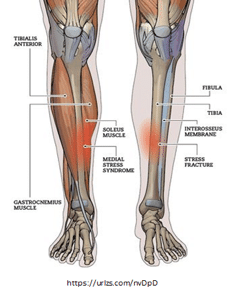
The weather is finally nice (and rain free!) and you start getting back into your old running routine, everything is going great until you start feeling that aching/burning pain in the front of your leg. Shin splints are a common running injury and sideline runners for quite some time. What is the actual cause of this pain and how do you treat it?
Shin splint pain can be muscular related pain or it can be bone related which is also called medial tibial stress syndrome. What happens is that the impact from landing on your feet with running can cause your bone and muscle tissue to break down and start to swell and become inflamed. If you continue to run when your shins are hurting, over time this will cause further break down and this is when people may develop a stress reaction or fracture. Bone injuries take longer to heal, so if you are having shin pain start physical therapy right away!
Overtraining/ overuse injuries like shin splints occur when you increase your intensity, duration or frequency of impact exercise such as running too quickly. It is important to have a good training program that is gradual. There are some other causes for shin splints and your physical therapist can help you identify what these are. A few of these are listed below:
Causes:
- Running mechanics
- Foot posture/shoe wear
- Ankle/Hip weakness
- Training errors
- Increase intensity/ frequency
- Hill training early in season/ in training
- Running on cement or hard surfaces
- Bone Mineral Density
- Nutrition
Treatment can include a variety of options. Often times soft tissue work helps to improve the healing process. Check out this video on ART or Active Release Technique for shin splints.
Your therapist may work on some of the muscles involved and also have you stretch and or foam/roll. During your initial exam we will identify specific areas of weakness. As a runner, it is important to have strong core, hips, quads and foot muscles. Check out this video by Dr. Korn on foot intrinsic strengthening. Working these muscles can help if one of the causes of your shin splints is flat feet.
Lastly, taking some rest time may be needed. During this time performing biking, swimming or elliptical can keep you moving while being less impact on your joints. Performing strength training is also very important!
Want to be evaluated by a therapist for some of the above causes?
Call to make an appointment today!
Medford~WestBerlin~Haddonfield
Categorized as: Ankle & Foot,ART - Active Release,Sports Injury